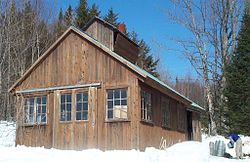Sugar shack
This articleneeds additional citations forverification.(July 2022) |

Asugar shack(French:cabane à sucre), also known assap house,sugar house,sugar shantyorsugar cabinis an establishment, primarily found inEastern Canadaand northernNew England.Sugar shacks are small cabins or groups of cabins wheresapcollected frommapletrees is boiled intomaple syrup.They are often found on the same territory as thesugar bush,which is intended for cultivation and production of maple syrup by way of craftsmanship (as opposed to global mass production factories built for that purpose in the 20th century).[1]
Syrup production[edit]
Historically, sugar shacks were developed through a combination of Native American and European innovations. French explorer and colonistPierre Boucherdescribed observing indigenous peoples making maple sugar in 1664. Maple sugar fabrication was introduced toNew Franceby settlers ofSwissandNorman Frenchorigin during the 17th century. Their goal was the production of syrup for trade or sale, and for personal use during the cold winter months. After the British conquest of 1763, the practice spread to the provinces ofOntario,New BrunswickandNova Scotia,but remained a primarily family-relatedcottage industryinQuebec.
Food and recreational services[edit]
Today many sugar shacks are commercially operated. Some offer reception halls and outdoor activities, open to the general public during certain months. Some of these activities include sleigh-riding, tours of the grounds, and eatingmaple toffeemade in the house, often in front of the customers. The reception halls often cater to large groups, offering dishes complemented by maple syrup such asham,bacon,sausages,baked beans,scrambled eggs,pork rinds(includingOreilles de crisse) andpancakes.Other specialities include pickles and bread, followed by desserts such assugar cream pieandmaple taffyon the snow.[2]
The busier period for sugar shacks is from March to the end of April, which is when maple sap becomes available. However, at temperatures below 0 degrees Celsius, it is almost impossible to extract the sap, and therefore collection efforts are focussed in the thawing period of early spring. The ideal time is when temperatures drop below freezing at night and rise above freezing during the day.[3]Sap collection is usually performed during the two first weeks of April, which has become the focus of an annual spring celebration.
References[edit]
- ^Spencer, James Burns (1913).The Maple Sugar Industry in Canada.Bulletin No. 2 B. Ottawa: Dominion of Canada, Department of Agriculture. pp. 21–25.RetrievedSeptember 14,2022– via Google Books.
- ^Schwaner-Albright, Oliver (3 February 2009)."In Quebec, Feasting and Staying Where Maple Syrup Is Made"– via NYTimes.com.
- ^Benn, Ryan (11 February 2019)."The Magic of Maple".Alive Magazine.Retrieved1 July2022.
